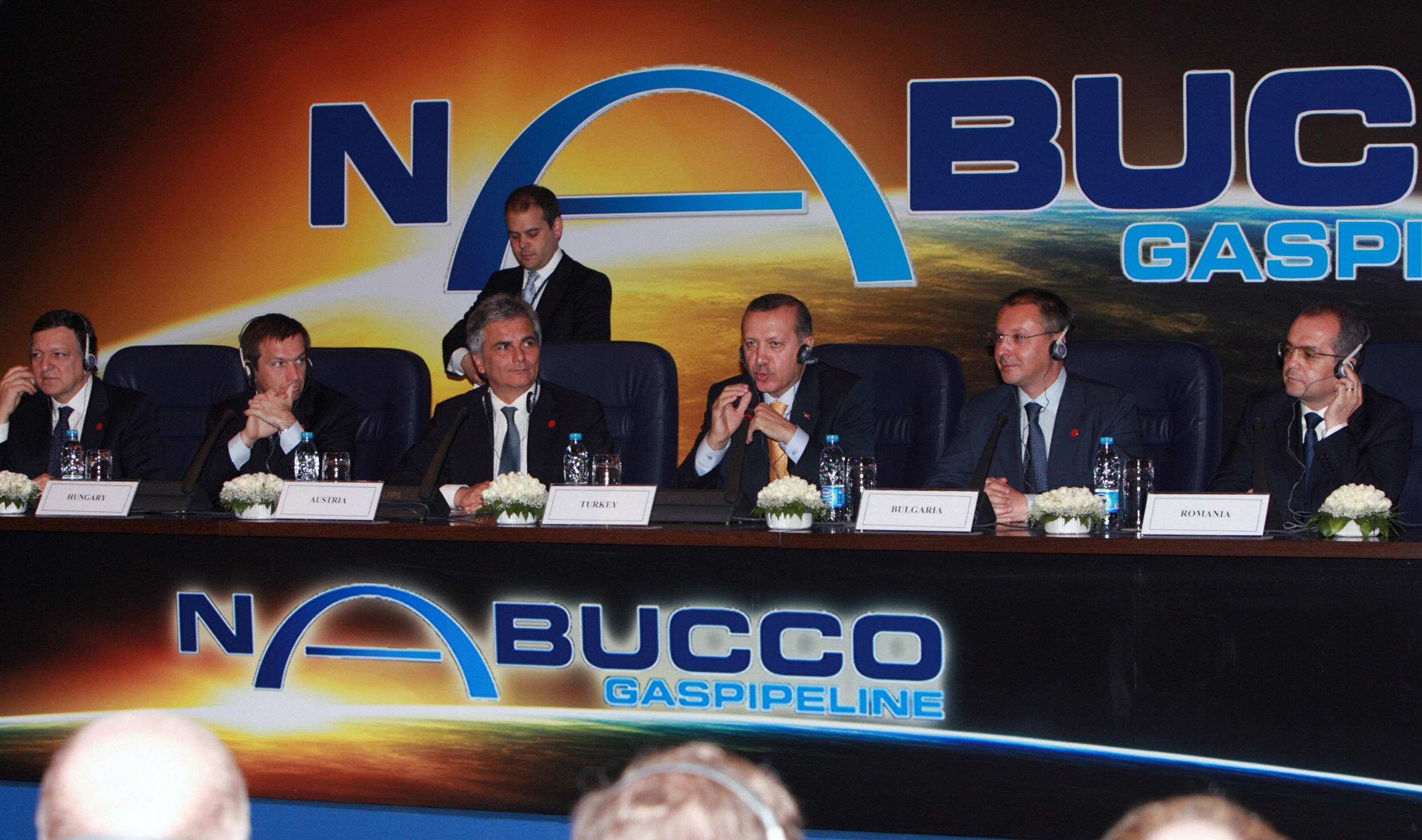
Old and New Options Considered in the Post-Nabucco Era
Publication: Eurasia Daily Monitor Volume: 10 Issue: 123
By:

Planning the Southern Gas Corridor to Europe, the European Commission in Brussels had defined the Nabucco pipeline project as the corridor’s mainstay. With Nabucco-West’s official demise (see accompanying article and EDM, June 27), the gas producer, transiting and consumer countries situated between Turkmenistan and Central Europe have begun recalculating their options for a post-Nabucco era.
The Trans-Adriatic Pipeline project (TAP) has defeated Nabucco-West in the contest for access to Azerbaijani gas. TAP will carry 10 billion cubic meters (bcm) of gas annually from Shah Deniz toward Italy. The same pipeline project also proposes to add another 10 bcm per year (sometime after 2020) on the same route to Italy, without significant investment, simply by adding compressor capacity to the TAP pipeline. In effect, the Nabucco-West project has lost its supply base.
After eleven years of futile efforts, Nabucco’s shareholders led by Austrian OMV will not keep a failed project afloat, nor continue financing its operating expenses (as Hungarian MOL had anticipated more than one year ago). Drawing from the consequences of Nabucco-West’s defeat, OMV’s CEO Gerhard Roiss announced: “The Nabucco project is over for us” (Die Presse, June 27; see below).
During the Nabucco-TAP contest, the European Commission had insisted that the winner project would “open” the Southern Corridor, strongly implying that the other project would be implemented next. According to this logic, the two projects could be sequenced; the contest over Shah Deniz gas would merely determine the order of sequencing Nabucco-West and TAP; and they would coexist in the future, each supplying Caspian gas to different parts of the European market, once a trans-Caspian pipeline from Turkmenistan materializes.
That logic, however, is not being borne out now. There will not be another iteration of Nabucco-West without guaranteed supply sources and financing. Connecting the Caspian basin with Central Europe will be a matter for a post-Nabucco project. This will require a stronger consortium and more credible leadership than has been the case until now (see accompanying article).
Turkmenistan is not hastening to comment on Nabucco-West’s demise. A trans-Caspian pipeline from Turkmenistan is integral to the European Union–planned Southern Gas Corridor. From Ashgabat’s perspective, a section of the planned gas highway to Central Europe has now fallen off. Nabucco’s capacity (even as Nabucco-West) could have accommodated significant volumes of Turkmenistan’s gas. The TAP project does not have sufficient capacity for that, and its shareholders prefer dedicating TAP’s capacity to their own gas. Ashgabat would almost certainly welcome a credible post-Nabucco pipeline route to Central Europe. Turkmenistani gas could then flow to that market through the planned Trans-Anatolia pipeline, an Azerbaijani-led project.
Baku is interested in supplying Central Europe with gas from Azerbaijani fields other than Shah Deniz. The Absheron, Umid-Babek, Shafag-Asiman and ACG-Deep projects are envisaged to start commercial production by 2020 and thereafter. According to the president of Azerbaijan’s State Oil Company (SOCAR), Rovnag Abdullayev, “We see the pipeline route toward Austria as a natural market for that gas. The development planning of both pipeline routes lays the foundation for future growth” (press release, June 28).
Bulgaria is the sole Nabucco country that would not necessarily lose from Nabucco’s defeat. The TAP consortium has already suggested that it might supply Bulgaria with some limited gas volumes (to be determined) via the Interconnector Greece-Bulgaria. The IGB, partially EU-funded, is currently under construction though behind schedule. SOCAR has just won the tender for majority ownership of Greece’s gas pipelines, and through that, an ownership stake in the interconnector to Bulgaria. Azerbaijan reaffirms its known interest in selling small gas volumes in Bulgaria and elsewhere in the Balkans (Trend, June 28).
Meanwhile, Bulgaria’s Socialist-led government will exploit Nabucco-West’s failure as a major argument for joining Gazprom’s South Stream project. The government has just initiated a promotional effort for South Stream in Bulgaria. Economy and Energy Minister Dragomir Stoynev strongly emphasizes a “long-term commitment” of Bulgaria to South Stream (www.naturalgaseurope, BTA, June 26; Novinite, June 27).
Romanian President Traian Basescu and the government, while co-habitating as political antagonists, had equally supported the Nabucco project, with a consistency of purpose unmatched elsewhere in the region. Indeed, Bucharest initiated collective appeals by the Nabucco countries to the European Union and to Azerbaijan, making the case for Nabucco-West in the run-up to the pipeline selection decision. Following Nabucco’s failure, Basescu and Prime Minister Victor Ponta are now emphasizing the commercial potential of local shale gas as well as natural gas on Romania’s Black Sea continental shelf. At present, Chevron is exploring for shale gas onshore, while a consortium of ExxonMobil and OMV explores natural has offshore. The size and commerciality of these reserves remains to be determined, however. Meanwhile, Russia is likely to propose building a South Stream branch-off line from Bulgaria into Romania (Ziarul Financiar, June 27; Agerpres, June 28).
In Vienna, OMV’s CEO Gerhard Roiss indicated a complete shift away from reliance on Caspian gas, commenting: “Our goal now is, European gas for European customers.” According to the Nabucco project company’s press release, the emphasis would now shift on “developing opportunities based on alternative gas sources.” Both assertions allude, first and foremost, to OMV’s joint project with ExxonMobil in Romania (see above).
That offshore field is estimated to contain between 40 bcm and 85 bcm of natural gas. OMV characterizes that quantity as the biggest find in the company’s history (albeit with Exxon in this case). Further exploration may yield more; but, in terms of orders of magnitude, it seems likely to remain a far cry indeed from the size of Caspian reserves. During the Nabucco-TAP contest, OMV had suggested a pipeline link from that Black Sea offshore project (in Romania’s east) to the Nabucco trunkline that would have crossed Romania’s west. The June 28 press release seems to allude again to that idea (Die Presse, June 27; OMV press release, June 28).
The Continental European Gas Hub at Baumgarten near Vienna will continue to suffer from limited competition to the Russian gas flooding the terminal. Nabucco gas would have introduced a greater element of competition, contributing to the development of spot-market pricing. With Nabucco’s defeat, however, Gazprom will continue to dominate the price-setting process in Central Europe (Wirtschaftsblatt, June 26).




